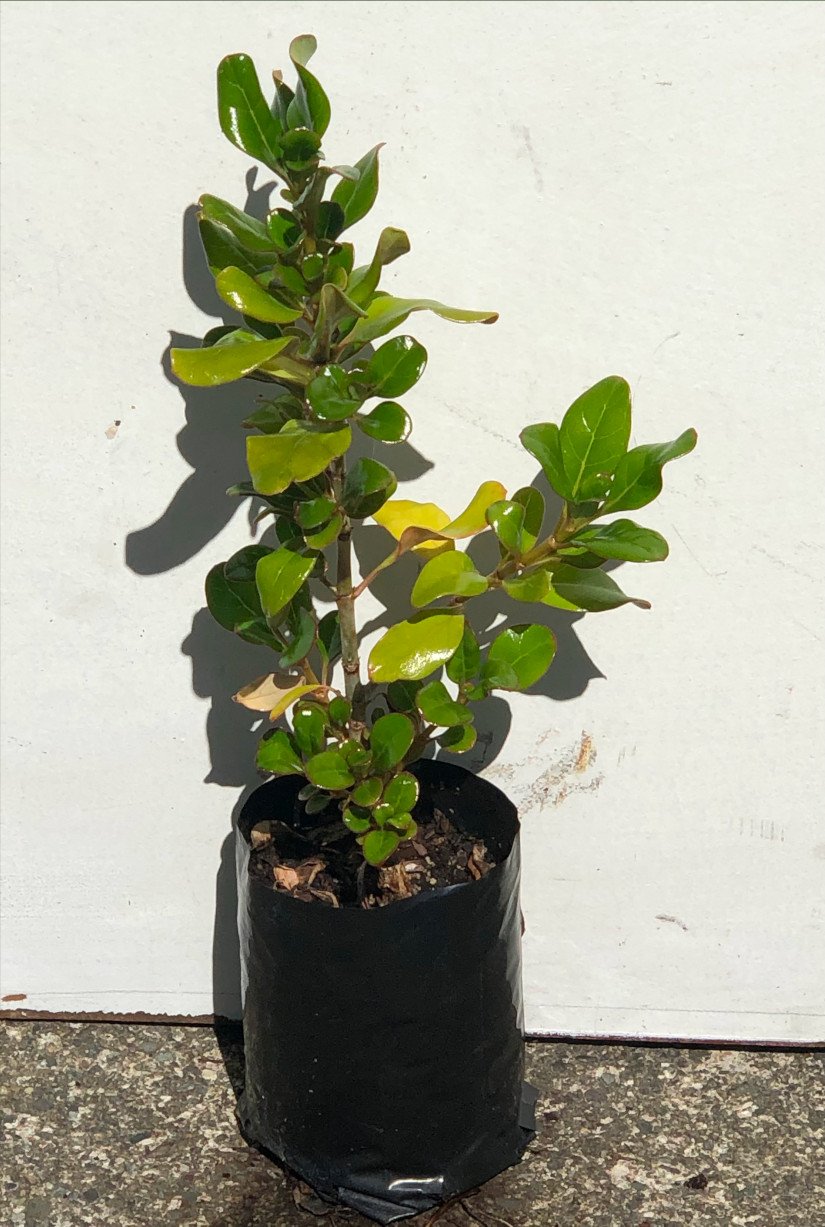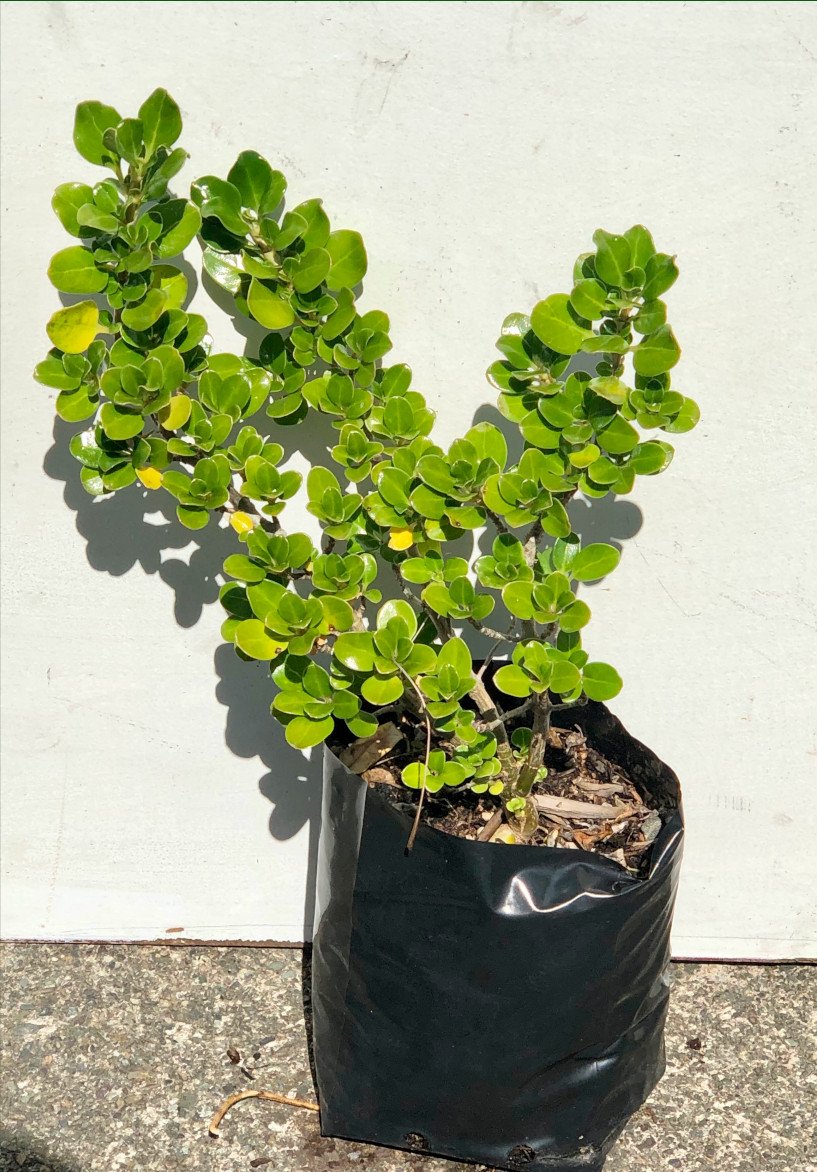 Image 1 of 5
Image 1 of 5

 Image 2 of 5
Image 2 of 5

 Image 3 of 5
Image 3 of 5

 Image 4 of 5
Image 4 of 5

 Image 5 of 5
Image 5 of 5






Coprosma repens - Mirror Plant, Taupata
Coprosma repens, also known as Taupata or Mirror Plant, is an attractive species commonly found on the edge of coastal forests and seaside rocks. It is a low-growing shrub or small tree, featuring shiny dark green leaves with a distinctive leathery texture and small pits at the junction of veins. The leaves grow in pairs and range from 6-8cm long. While this species can be quite vigorous and sometimes weedy, it is valued for its hardiness and aesthetic appeal in coastal gardens.
Growing Conditions:
• Tolerances: Sand, sun, wind, coastal environments, and salt.
• Endemic Distribution: Found in Three Kings Islands, North and South Islands, extending as far south as Greymouth in the west and Rarangi in the east. It is now naturalised throughout the South Island, Stewart Island, and the Chatham Islands.
Specifications:
• Height: Up to 6m.
• Flowering: Green or white flowers from June – February.
• Fruiting: Orange fruit from June – July.
Ideal Uses:
• Bird food / Attractant
• Bee food
• Hedging
• Riparian plantings
• Pioneer plantings
Taupata is a vigorous, low-maintenance plant ideal for coastal gardens and naturalised spaces. Its shiny leaves, hardiness, and ability to self-sow make it well-suited for windy, coastal areas, as well as riparian and pioneer plantings.
Approximate product size & price:
• PB3/4 (5cm – 20cm, 350ml): $6 each | 9 for $45
• PB3 (20cm – 70cm, 1.5L): $12 each | 5 for $50
• PB8 (50cm+, 3.5L): $24 each | 4 for $80
More than happy to mix and match bulk pricing with plants of the same price range.
Timeframe:
We ship Monday – Wednesday for South Island customers and Monday/Tuesday for Rural and North Island customers. Orders placed outside of these days will be fulfilled the following week.
Local pick ups and/or deliveries will be made by arrangement.
Need a custom shipping quote? If the set pricing seems a bit steep, get in touch with us at Nelson Natives, and we’ll see what we can do.
“We’ll donate $1 per plant sold to national conservation efforts, helping to protect and restore New Zealand’s natural heritage”
Coprosma repens, also known as Taupata or Mirror Plant, is an attractive species commonly found on the edge of coastal forests and seaside rocks. It is a low-growing shrub or small tree, featuring shiny dark green leaves with a distinctive leathery texture and small pits at the junction of veins. The leaves grow in pairs and range from 6-8cm long. While this species can be quite vigorous and sometimes weedy, it is valued for its hardiness and aesthetic appeal in coastal gardens.
Growing Conditions:
• Tolerances: Sand, sun, wind, coastal environments, and salt.
• Endemic Distribution: Found in Three Kings Islands, North and South Islands, extending as far south as Greymouth in the west and Rarangi in the east. It is now naturalised throughout the South Island, Stewart Island, and the Chatham Islands.
Specifications:
• Height: Up to 6m.
• Flowering: Green or white flowers from June – February.
• Fruiting: Orange fruit from June – July.
Ideal Uses:
• Bird food / Attractant
• Bee food
• Hedging
• Riparian plantings
• Pioneer plantings
Taupata is a vigorous, low-maintenance plant ideal for coastal gardens and naturalised spaces. Its shiny leaves, hardiness, and ability to self-sow make it well-suited for windy, coastal areas, as well as riparian and pioneer plantings.
Approximate product size & price:
• PB3/4 (5cm – 20cm, 350ml): $6 each | 9 for $45
• PB3 (20cm – 70cm, 1.5L): $12 each | 5 for $50
• PB8 (50cm+, 3.5L): $24 each | 4 for $80
More than happy to mix and match bulk pricing with plants of the same price range.
Timeframe:
We ship Monday – Wednesday for South Island customers and Monday/Tuesday for Rural and North Island customers. Orders placed outside of these days will be fulfilled the following week.
Local pick ups and/or deliveries will be made by arrangement.
Need a custom shipping quote? If the set pricing seems a bit steep, get in touch with us at Nelson Natives, and we’ll see what we can do.
“We’ll donate $1 per plant sold to national conservation efforts, helping to protect and restore New Zealand’s natural heritage”